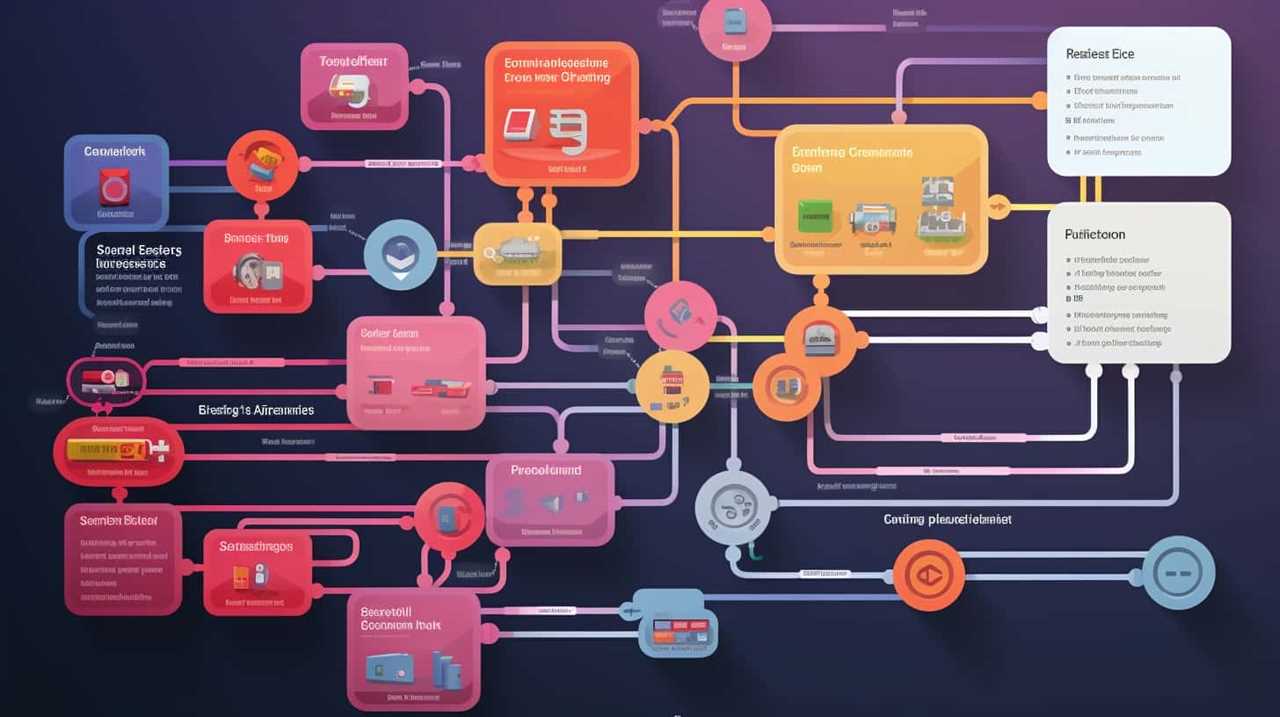Are you prepared to elevate your kid’s apparel shop to the next tier?
With Google Ads, we’ll help you dress up your online presence like never before. Just like a well-tailored outfit, our powerful ads will target your ideal audience, increase your online visibility, and drive traffic to your store.
Get ready to boost your sales with compelling ads and explore local advertising options. With analytics, budgeting, and staying ahead of the competition, success is just a click away.
Key Takeaways
- Google Ads provides powerful targeting options, allowing children’s clothing stores to reach a highly specific audience interested in their products.
- Effective targeting strategies, such as selecting websites and platforms frequented by parents and scheduling ads during the most effective times, are crucial for reaching the right audience at the right time.
- Increasing online visibility through Google Ads and social media marketing can boost brand awareness and drive traffic to the online store, leading to potential sales.
- Driving traffic and boosting sales can be achieved by targeting a relevant audience, optimizing keywords and ad placements, designing eye-catching display ads with compelling ad copy, and leveraging remarketing strategies.
The Power of Google Ads
In our experience, utilizing Google Ads has proven to be a powerful tool for boosting the online presence of children’s clothing stores. The power of Google Ads lies in its ability to provide powerful targeting options and deliver effective advertisements. With Google Ads, you can reach a highly specific audience that’s interested in children’s clothing, ensuring that your ads are seen by potential customers who are most likely to make a purchase.

One of the key strengths of Google Ads is its powerful targeting capabilities. You can target your ads based on factors such as location, age, gender, and interests, allowing you to tailor your message to the right audience. This precision targeting ensures that your ads aren’t wasted on individuals who are unlikely to be interested in children’s clothing, maximizing the effectiveness of your advertising budget.
Furthermore, Google Ads have proven to be highly effective in driving results for children’s clothing stores. The platform provides detailed analytics and insights, allowing you to constantly monitor and optimize your ads for maximum impact. You can track metrics such as click-through rates, conversion rates, and return on investment, enabling you to make data-driven decisions to improve the performance of your campaigns.
Targeting Your Ideal Audience
When it comes to targeting our ideal audience for children’s clothing stores, there are three crucial points to consider.
First, we must ensure that our ad content is age-appropriate, capturing the attention of both children and their parents.

Second, we need to implement effective targeting strategies to reach the right audience at the right time.
And finally, we must recognize the importance of reaching parents online, as they’re the ones making the purchasing decisions.
Age-Appropriate Ad Content
We believe that creating age-appropriate ad content is crucial when targeting our ideal audience of children for our children’s clothing store. Ethical advertising for children means considering their age and ensuring that the content is suitable for them. Here are three reasons why age-appropriate ad targeting is essential:
- Protecting children: By creating ads that are tailored to their age group, we can protect children from being exposed to inappropriate content. We’ve a responsibility to prioritize their well-being and create a safe online environment.
- Building trust: When children and their parents see ads that are relevant to their age and interests, it builds trust in our brand. They feel understood and valued, which increases their likelihood of engaging with our products and services.
- Enhancing brand reputation: By showcasing our commitment to ethical advertising, we establish ourselves as a trusted and responsible children’s clothing store. This helps us attract more customers and differentiate ourselves from competitors.
Effective Targeting Strategies
How can we effectively target our ideal audience for children’s clothing stores using Google Ads?

One key strategy is to focus on ad placement and ad scheduling. By carefully selecting where our ads appear and when they’re shown, we can maximize our chances of reaching the right audience at the right time.
When it comes to ad placement, it’s important to consider websites and platforms that parents and caregivers frequently visit. This could include parenting blogs, social media platforms, or websites dedicated to family activities. By targeting these specific channels, we can ensure that our ads are seen by the people most likely to be interested in our children’s clothing products.
Additionally, ad scheduling allows us to control when our ads are shown. By analyzing data and understanding our target audience’s online behavior, we can determine the most effective times to display our ads. For example, if our audience is most active in the evening after work, we can schedule our ads to appear during this prime time.
Reaching Parents Online
To effectively reach parents online and target our ideal audience for children’s clothing stores, we can continue the discussion from the previous subtopic by focusing on the importance of understanding their preferences and interests. By doing so, we can engage our audience in a more meaningful way and increase the chances of converting them into loyal customers.

Here are three key strategies to consider:
- Conduct thorough market research: By understanding the preferences and interests of parents, we can tailor our online marketing efforts to align with their needs. This includes analyzing their shopping habits, favorite brands, and preferred online platforms.
- Create compelling content: Engaging parents online requires creating content that speaks directly to their desires and concerns. Whether it’s through blog posts, social media updates, or videos, we must provide valuable information and showcase our products in a way that resonates with them.
- Utilize targeted advertising: With the help of Google Ads, we can reach parents who are actively searching for children’s clothing online. By utilizing keywords and demographic targeting, we can ensure our ads are seen by our ideal audience, increasing the likelihood of conversions.
Increasing Online Visibility
Although it may seem challenging, increasing online visibility for children’s clothing stores can be achieved through strategic implementation of Google Ads. By utilizing this powerful advertising platform, you can effectively reach your target audience and boost your brand awareness. One of the key strategies for increasing online visibility is through social media marketing. Creating engaging content and promoting it on popular social media platforms such as Facebook, Instagram, and Pinterest can help you connect with potential customers and drive traffic to your online store.
To further illustrate the importance of increasing online visibility, consider the following table:
| Online Visibility Strategies | Benefits |
|---|---|
| Utilizing Google Ads | – Increased website traffic |
| – Higher conversion rates | |
| – Enhanced brand recognition | |
| Social media marketing | – Expanded reach |
| – Increased customer engagement | |
| – Improved brand loyalty |
As you can see, implementing Google Ads and social media marketing can have a significant impact on your online visibility. By focusing on these strategies, you can effectively increase your brand awareness and attract more customers to your children’s clothing store. So, don’t overlook the power of online advertising and make sure to invest in the right tools and strategies to maximize your online presence.

Driving Traffic to Your Store
Let’s talk about how to drive traffic to your store using Google Ads.
One effective strategy is targeting a relevant audience. By identifying the demographics and interests of your potential customers, you can create tailored ad campaigns that will attract the right people to your children’s clothing store.
Another crucial aspect is optimizing your ad campaigns. This involves constantly monitoring and adjusting your keywords, ad placements, and ad formats to ensure maximum visibility and engagement.
With the right targeting and optimization techniques, you can drive more traffic to your store and increase your chances of making sales.

Targeting Relevant Audience
By using targeted Google Ads, we can effectively drive traffic to our children’s clothing store. To ensure we reach the right audience, we can utilize two key strategies: demographic targeting and behavioral targeting.
- Demographic targeting: This approach allows us to focus our ads on specific age groups, gender, and locations. By tailoring our ads to match the preferences and needs of our target demographic, we can increase the chances of attracting relevant customers to our store.
- Behavioral targeting: With this method, we can analyze users’ online behaviors and interests to deliver ads that align with their preferences. By understanding what our potential customers are searching for or engaging with online, we can create ads that resonate with their interests and increase the likelihood of them visiting our store.
By implementing these targeted approaches, we can drive highly relevant traffic to our children’s clothing store and increase the chances of conversions.
Now, let’s explore how we can optimize our ad campaigns to maximize their effectiveness.
Optimizing Ad Campaigns
To maximize the effectiveness of our targeted Google Ads, we’ll optimize our ad campaigns to drive traffic to our children’s clothing store.

Optimizing ad campaigns involves two key aspects: optimizing ad bidding and improving ad targeting.
Firstly, optimizing ad bidding is crucial in ensuring that we get the best return on our advertising investment. By carefully analyzing our data and adjusting our bidding strategy, we can ensure that we’re bidding the right amount for each click, maximizing our chances of getting quality traffic to our store.
Secondly, improving ad targeting is essential in reaching the right audience and driving relevant traffic to our website. By refining our targeting parameters such as demographics, location, and interests, we can ensure that our ads are shown to the people who are most likely to be interested in our children’s clothing.
By optimizing ad bidding and improving ad targeting, we can increase the effectiveness of our Google Ads and drive more traffic to our children’s clothing store.

Now, let’s move on to the next section and discover how to boost sales with compelling ads.
Boosting Sales With Compelling Ads
We can enhance sales by creating compelling ads for our children’s clothing store using Google Ads. To create ads that truly stand out and capture the attention of our target audience, we need to focus on two key elements: compelling visuals and precise ad targeting.
- Compelling visuals: A picture is worth a thousand words, and in the world of online advertising, it can make all the difference. We need to use high-quality images that showcase our best-selling products and highlight their unique features. By using vibrant colors, adorable models, and engaging backgrounds, we can create visuals that instantly grab the attention of potential customers.
- Ad targeting: In order to maximize our sales potential, we need to ensure that our ads are reaching the right people at the right time. By leveraging Google Ads’ targeting options, we can narrow down our audience based on factors such as demographics, interests, and online behavior. This allows us to deliver our ads to those who are most likely to be interested in our children’s clothing products.
By combining compelling visuals with precise ad targeting, we can create ads that not only catch the eye but also resonate with our target audience.
In the next section, we’ll explore the art of crafting attention-grabbing ad copy to further boost our sales.

Crafting Attention-Grabbing Ad Copy
Let’s dive into the art of creating attention-grabbing ad copy for our children’s clothing store using Google Ads. Crafting compelling headlines and creating effective call to actions are essential in capturing the attention of our target audience and driving them to take action.
To create a headline that grabs attention, we need to be creative and concise. We can use words like "adorable," "stylish," or "trendy" to describe our clothing line. For example, "Dress Your Little Ones in Adorable and Stylish Outfits!" This headline not only emphasizes the attractiveness of our products but also appeals to parents’ desire to dress their children in fashionable clothes.
In addition to catchy headlines, we must create effective call to actions that encourage our audience to take the desired action. Words like "shop now," "discover," or "get your little one’s wardrobe ready" can prompt our customers to click on our ads and explore our online store.
To further illustrate the importance of crafting attention-grabbing ad copy, here is a table showcasing examples of compelling headlines and effective call to actions:

| Headline Examples | Call to Action Examples |
|---|---|
| Dress Your Little Ones in Style | Shop Now and Discover Our Latest Collection |
| Trendy and Affordable Kids Clothing | Get Your Little One’s Wardrobe Ready Today |
| Get Ready for Summer with Adorable Outfits | Explore Our Summer Collection Now |
Designing Eye-Catching Display Ads
Now let’s delve into creating visually striking display ads for our children’s clothing store using Google Ads. Designing captivating visuals and creating compelling ad copy are crucial in attracting the attention of potential customers.
Here are three key tips to help you design eye-catching display ads:
- Use vibrant colors and attractive imagery: Children are drawn to bright and colorful visuals. Incorporate lively colors and images that showcase your clothing line in a fun and engaging way. Consider using pictures of happy children wearing your clothes to evoke positive emotions and create a connection with your target audience.
- Keep the ad copy concise and persuasive: Capture your audience’s attention with catchy headlines and concise, persuasive text. Highlight the unique features of your clothing, such as durability, comfort, or fashionable designs. Use powerful language that appeals to parents’ desires to dress their children in stylish and high-quality outfits.
- Include a clear call-to-action: Guide potential customers towards taking action by including a clear call-to-action in your display ads. Whether it’s ‘Shop Now,’ ‘Discover Our Collection,’ or ‘Get Your Kids Styled Today,’ make sure it stands out and entices users to click on your ad and visit your website.
By implementing these strategies, you can create visually appealing display ads that effectively promote your children’s clothing store.
Now, let’s explore how to further enhance your online presence by utilizing product listing ads.

Utilizing Product Listing Ads
To effectively promote our children’s clothing store online, we can leverage the power of product listing ads. These ads are a great way to showcase our products and attract potential customers. By optimizing our product feed and implementing effective ad bidding strategies, we can maximize the impact of our ads and drive more traffic to our website.
To ensure that our product listing ads are successful, we need to focus on product feed optimization. This involves providing accurate and detailed information about our products, including their attributes, such as size, color, and material. By optimizing our product feed, we can improve the visibility and relevance of our ads, increasing the likelihood of attracting potential customers.
In addition to product feed optimization, implementing effective ad bidding strategies is crucial. Ad bidding determines how much we’re willing to pay for each click on our ads. By carefully analyzing the competition and setting appropriate bid amounts, we can ensure that our ads are displayed to the right audience at the right time, maximizing our chances of conversion.
With product feed optimization and effective ad bidding strategies in place, we can now move on to the next step of maximizing our online presence: maximizing mobile advertising.

Maximizing Mobile Advertising
When it comes to maximizing mobile advertising, there are three key points to consider.
First, mobile ad targeting allows us to reach our target audience on their devices wherever they are.
Second, optimizing ad content for mobile users ensures that our ads are engaging and visually appealing.

Lastly, tracking ad performance on mobile platforms gives us valuable insights into the effectiveness of our campaigns, allowing us to make data-driven decisions for better results.
Mobile Ad Targeting
We can maximize our mobile advertising efforts by utilizing targeted Google Ads for children’s clothing stores. Mobile ad targeting allows us to reach our desired audience effectively and efficiently.
Here are three ad targeting strategies to consider for mobile ad placement:
- Location-based targeting: By using geolocation technology, we can target our ads to specific geographic areas where our potential customers are located. This ensures that our ads are reaching the right people at the right time, increasing the chances of conversion.
- Demographic targeting: Understanding our target audience’s demographics, such as age, gender, and interests, allows us to create personalized and relevant ads. By tailoring our messaging to specific demographics, we can capture their attention and drive engagement.
- Behavioral targeting: Analyzing user behavior, such as browsing history and app usage, enables us to target individuals who’ve shown an interest in children’s clothing. This approach allows us to deliver ads to those who are more likely to convert, maximizing our advertising efforts.
Optimizing Ad Content
Our next step in maximizing mobile advertising for children’s clothing stores is to optimize the ad content for maximum impact.

Effective ad targeting is crucial, but it’s equally important to ensure that the content of your ads is compelling and persuasive. To achieve this, we need to employ ad optimization strategies that will captivate our audience and drive them to take action.
One key strategy is to use eye-catching visuals that showcase your clothing items in an appealing way. Additionally, crafting concise and compelling ad copy that highlights the unique features and benefits of your products will help grab the attention of potential customers.
By optimizing your ad content, you can increase engagement and conversions, ultimately boosting the success of your online presence.
Now, let’s move on to the next step: tracking ad performance.

Tracking Ad Performance
To gauge the effectiveness of our mobile advertising efforts, it’s essential to track the performance of our ads in order to make data-driven decisions and optimize our campaigns for maximum impact. Tracking ad effectiveness and analyzing campaign data allows us to understand what works and what doesn’t, enabling us to tweak our strategies for better results.
Here are three reasons why tracking ad performance is crucial for maximizing mobile advertising:
- Measure ROI: By tracking the performance of our ads, we can determine the return on investment (ROI) of our campaigns. This helps us identify which ads are generating the most revenue and allocate our budget accordingly.
- Identify top-performing platforms: Tracking ad performance allows us to see which platforms or channels are driving the most traffic and conversions. This information helps us focus our efforts on the platforms that deliver the best results.
- Optimize targeting and messaging: By analyzing campaign data, we can gain insights into our target audience’s preferences and behaviors. This enables us to refine our targeting and tailor our messaging to better resonate with our audience, increasing the chances of engagement and conversion.
Tracking ad effectiveness and analyzing campaign data are essential steps in maximizing mobile advertising. By leveraging this data, we can make informed decisions, optimize our campaigns, and achieve maximum impact.
Monitoring and Optimizing Campaigns
Monitoring and optimizing campaigns is an essential aspect of running successful Google Ads for children’s clothing stores. It allows us to track the effectiveness of our ads and make necessary improvements to our ad targeting. By monitoring our campaigns closely, we can gain valuable insights into which ads are performing well and which ones are not. This information helps us make data-driven decisions to optimize our campaigns and maximize our return on investment.

To track ad effectiveness, we utilize various metrics such as click-through rates, conversion rates, and cost per acquisition. These metrics provide us with a clear picture of how our ads are resonating with our target audience. We can identify which ads are driving the most engagement and conversions, enabling us to allocate our budget more effectively.
In addition to tracking ad performance, we continuously work on improving our ad targeting. We analyze demographic data, search trends, and customer behavior to refine our targeting strategies. This ensures that our ads are reaching the right audience at the right time, increasing the chances of conversion.
By monitoring and optimizing our campaigns, we can stay ahead of the competition and drive better results for our children’s clothing store.
In the next section, we’ll explore the power of leveraging remarketing strategies to further enhance our online presence and increase conversions.

Leveraging Remarketing Strategies
By implementing remarketing strategies, we can effectively reengage potential customers who’ve previously shown interest in our children’s clothing store. Remarketing techniques allow us to target specific audiences and deliver personalized advertising that resonates with their interests and needs.
Here are three ways we can leverage remarketing strategies to enhance our online presence:
- Tailor-made messaging: With personalized advertising, we can create tailored messages that speak directly to our potential customers. By analyzing their previous interactions with our website, we can understand their preferences and showcase products that align with their interests. This approach not only grabs their attention but also increases the likelihood of conversion.
- Dynamic product ads: Remarketing techniques enable us to show ads featuring specific products that potential customers have previously viewed on our website. By reminding them of the items they were interested in, we can increase their desire to make a purchase. This personalized approach enhances the overall shopping experience and boosts customer loyalty.
- Cross-device targeting: People today use multiple devices to browse and shop online. With remarketing strategies, we can target potential customers across different devices, ensuring that our ads reach them wherever they are. This seamless omnichannel experience keeps our brand top-of-mind and maximizes the chances of conversion.
Exploring Local Advertising Options
As part of our marketing strategy, we’ll delve into the potential of local advertising options. Local marketing is an essential aspect of promoting our children’s clothing store and connecting with our target audience. By focusing on local marketing, we can establish a strong presence within our community and build lasting relationships with our customers.
One effective way to engage in local marketing is through community partnerships. Collaborating with other businesses and organizations in our area can help us reach a wider audience and gain credibility. For example, we can partner with local schools or daycare centers to offer special promotions or discounts to their students or families. This not only benefits our business but also strengthens our ties to the community.

Another local advertising option is to participate in local events and sponsor community initiatives. By sponsoring events such as school fundraisers or local fairs, we can raise awareness about our store and showcase our commitment to supporting the community. Additionally, we can consider hosting in-store events or workshops that cater to our target audience, such as a styling session or a fashion show for kids.
Measuring Success With Analytics
When it comes to measuring the success of your Google Ads campaign for your children’s clothing store, there are two key points that we need to discuss:
Key Performance Indicators (KPIs) and tracking conversion rates.
KPIs are the metrics that you’ll use to determine if your campaign is achieving its goals, such as click-through rates and cost per conversion.

Tracking conversion rates is essential to understand how many visitors are actually making a purchase on your website and allows you to optimize your ads for better results.
Key Performance Indicators
We track our success in online advertising for children’s clothing stores through key performance indicators (KPIs) measured with analytics. By measuring these KPIs, we can effectively track the return on investment (ROI) and determine the overall effectiveness of our advertising campaigns.
Here are three key performance indicators that we use to measure success:
- Click-through rate (CTR): This metric tells us how many users clicked on our ads compared to the number of times they were shown. A higher CTR indicates that our ads are engaging and relevant to our target audience.
- Conversion rate: This KPI measures the percentage of users who complete a desired action, such as making a purchase or signing up for a newsletter. A higher conversion rate indicates that our ads are effectively driving conversions and generating revenue.
- Cost per acquisition (CPA): This metric helps us understand how much we’re spending to acquire each customer. By optimizing our campaigns to achieve a lower CPA, we can increase profitability and maximize our advertising budget.
Tracking Conversion Rates
To effectively measure the success of our online advertising campaigns for children’s clothing stores, we track conversion rates using analytics. Tracking conversion rates allows us to see how many visitors to our website actually make a purchase or complete a desired action, such as signing up for our newsletter.

By analyzing this data, we can gain valuable insights into the effectiveness of our ads and make necessary adjustments to optimize our ad campaigns. Analytics provides us with detailed information on which ads are generating the most conversions, which keywords are driving the most traffic, and which landing pages are converting the best.
Armed with this knowledge, we can refine our targeting, messaging, and overall strategy to ensure that our ads are reaching the right audience and driving the desired results.
When it comes to online advertising, tracking conversion rates is crucial for measuring success and continuously improving our campaigns.
Budgeting and Cost Optimization
In the realm of budgeting and cost optimization for Google Ads, it’s crucial to carefully allocate resources and streamline expenses to maximize the online presence of children’s clothing stores. By implementing cost-effective strategies and conducting ROI analysis, we can ensure that every dollar spent on advertising yields the highest possible return on investment.

Here are three key considerations to keep in mind:
- Targeted Campaigns: Instead of casting a wide net, focus on specific demographics and locations that align with your target audience. This allows you to allocate your budget more effectively and reach the customers who are most likely to convert.
- Ad Optimization: Continuously monitor and optimize your ads to improve their performance. This could involve testing different ad formats, headlines, and images to determine which combinations generate the highest click-through rates and conversions.
- Keyword Research: Conduct thorough keyword research to identify the most relevant and cost-effective keywords for your campaigns. By targeting long-tail keywords with lower competition, you can reduce costs while still reaching customers who are actively searching for children’s clothing.
By implementing these cost-effective strategies and conducting regular ROI analysis, you can ensure that your Google Ads budget is being used efficiently to maximize your online presence and drive sales.
Now, let’s explore how staying ahead of the competition can further elevate your children’s clothing store.
Staying Ahead of the Competition
Continuing our journey towards maximizing the online presence of children’s clothing stores, let’s now explore how to stay ahead of the competition.

In today’s fast-paced and ever-evolving marketplace, staying competitive is crucial for the success of any business. One effective way to stay ahead is through thorough market research.
Market research allows you to gain insights into your target audience, understand their preferences, and identify emerging trends. By staying informed about what your competitors are doing, you can identify gaps in the market and find unique ways to differentiate yourself. This knowledge will help you develop strategies to attract and retain customers, ultimately boosting your sales and profitability.
When conducting market research, make sure to analyze demographic data, customer behavior, and buying patterns. This information will help you tailor your offerings to meet the specific needs and desires of your target audience. By staying up-to-date with industry news and trends, you can also anticipate changes and adapt your marketing strategies accordingly.
Frequently Asked Questions
How Can I Effectively Measure the Success of My Google Ads Campaign for My Children’s Clothing Store?
To measure the success of our Google Ads campaign for our children’s clothing store, we need to effectively track performance. By analyzing click-through rates, conversion rates, and return on investment, we can determine the campaign’s effectiveness and make informed decisions.

What Are Some Strategies to Optimize My Budget and Minimize Costs When Running Google Ads for My Children’s Clothing Store?
To optimize our budget and minimize costs when running Google Ads for our children’s clothing store, we focus on targeting specific demographics, refining keywords, and utilizing ad scheduling. These strategies help us maximize ad spend efficiency and drive meaningful results.
How Can I Stay Ahead of My Competitors in the Children’s Clothing Industry Using Google Ads?
To stay ahead of our competitors in the children’s clothing industry using Google Ads, we need to conduct thorough competitor analysis and implement effective ad targeting strategies. It’s the key to success.
What Are Some Local Advertising Options I Can Explore to Promote My Children’s Clothing Store?
Local partnerships and social media advertising are two effective options we can explore to promote our children’s clothing store. By teaming up with local businesses and utilizing targeted social media campaigns, we can reach our target audience and increase brand visibility.
What Are the Key Metrics and Analytics I Should Be Monitoring to Track the Performance of My Google Ads Campaign for My Children’s Clothing Store?
Monitoring performance and tracking success are essential when running a Google Ads campaign for our children’s clothing store. We must keep a close eye on key metrics and analytics to ensure that our ads are effective and driving desired outcomes.

Conclusion
In conclusion, harnessing the power of Google Ads can greatly enhance the online presence of children’s clothing stores. With targeted advertising and increased visibility, these stores can drive traffic to their websites and boost sales.
Did you know that businesses make an average of $2 in revenue for every $1 they spend on Google Ads? This statistic highlights the incredible potential for growth and success that comes with utilizing Google Ads for your children’s clothing store.
Don’t miss out on the opportunity to dress up your online presence and stay ahead of the competition.










